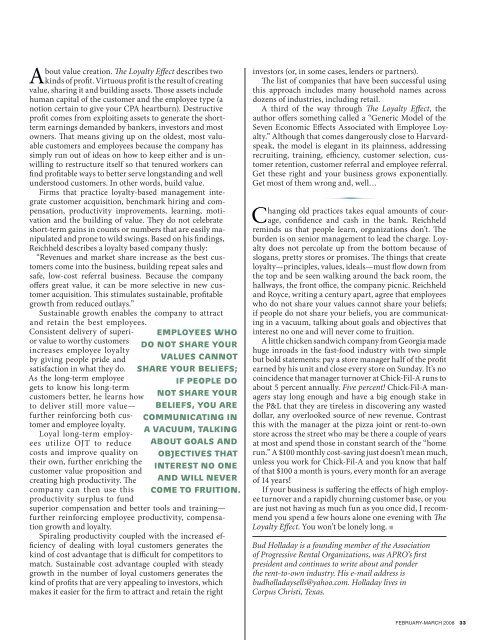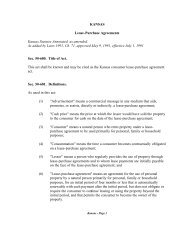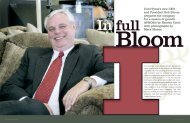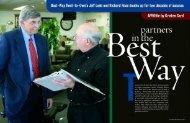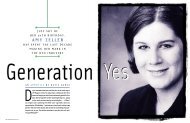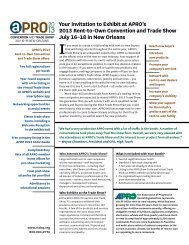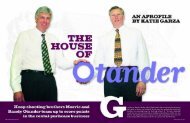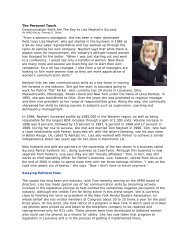Hiring - APRO
Hiring - APRO
Hiring - APRO
- No tags were found...
You also want an ePaper? Increase the reach of your titles
YUMPU automatically turns print PDFs into web optimized ePapers that Google loves.
About value creation. The Loyalty Effect describes twokinds of profit. Virtuous profit is the result of creatingvalue, sharing it and building assets. Those assets includehuman capital of the customer and the employee type (anotion certain to give your CPA heartburn). Destructiveprofit comes from exploiting assets to generate the shorttermearnings demanded by bankers, investors and mostowners. That means giving up on the oldest, most valuablecustomers and employees because the company hassimply run out of ideas on how to keep either and is unwillingto restructure itself so that tenured workers canfind profitable ways to better serve longstanding and wellunderstood customers. In other words, build value.Firms that practice loyalty-based management integratecustomer acquisition, benchmark hiring and compensation,productivity improvements, learning, motivationand the building of value. They do not celebrateshort-term gains in counts or numbers that are easily manipulatedand prone to wild swings. Based on his findings,Reichheld describes a loyalty based company thusly:“Revenues and market share increase as the best customerscome into the business, building repeat sales andsafe, low-cost referral business. Because the companyoffers great value, it can be more selective in new customeracquisition. This stimulates sustainable, profitablegrowth from reduced outlays.”Sustainable growth enables the company to attractand retain the best employees.Consistent delivery of superiorvalue to worthy customersincreases employee loyaltyby giving people pride andsatisfaction in what they do.As the long-term employeegets to know his long-termcustomers better, he learns howto deliver still more value—further reinforcing both customerand employee loyalty.Loyal long-term employeesutilize OJT to reducecosts and improve quality ontheir own, further enriching thecustomer value proposition andcreating high productivity. Thecompany can then use thisproductivity surplus to fundsuperior compensation and better tools and training—further reinforcing employee productivity, compensationgrowth and loyalty.Spiraling productivity coupled with the increased efficiencyof dealing with loyal customers generates thekind of cost advantage that is difficult for competitors tomatch. Sustainable cost advantage coupled with steadygrowth in the number of loyal customers generates thekind of profits that are very appealing to investors, whichmakes it easier for the firm to attract and retain the rightinvestors (or, in some cases, lenders or partners).The list of companies that have been successful usingthis approach includes many household names acrossdozens of industries, including retail.A third of the way through The Loyalty Effect, theauthor offers something called a “Generic Model of theSeven Economic Effects Associated with Employee Loyalty.”Although that comes dangerously close to Harvardspeak,the model is elegant in its plainness, addressingrecruiting, training, efficiency, customer selection, customerretention, customer referral and employee referral.Get these right and your business grows exponentially.Get most of them wrong and, well…∂Changing old practices takes equal amounts of courage,confidence and cash in the bank. Reichheldreminds us that people learn, organizations don’t. Theburden is on senior management to lead the charge. Loyaltydoes not percolate up from the bottom because ofslogans, pretty stores or promises. The things that createloyalty—principles, values, ideals—must flow down fromthe top and be seen walking around the back room, thehallways, the front office, the company picnic. Reichheldand Royce, writing a century apart, agree that employeeswho do not share your values cannot share your beliefs;if people do not share your beliefs, you are communicatingin a vacuum, talking about goals and objectives thatinterest no one and will never come to fruition.A little chicken sandwich company from Georgia madehuge inroads in the fast-food industry with two simplebut bold statements: pay a store manager half of the profitearned by his unit and close every store on Sunday. It’s nocoincidence that manager turnover at Chick-Fil-A runs toabout 5 percent annually. Five percent! Chick-Fil-A managersstay long enough and have a big enough stake inthe P&L that they are tireless in discovering any wasteddollar, any overlooked source of new revenue. Contrastthis with the manager at the pizza joint or rent-to-ownstore across the street who may be there a couple of yearsat most and spend those in constant search of the “homerun.” A $100 monthly cost-saving just doesn’t mean much,unless you work for Chick-Fil-A and you know that halfof that $100 a month is yours, every month for an averageof 14 years!If your business is suffering the effects of high employeeturnover and a rapidly churning customer base, or youare just not having as much fun as you once did, I recommendyou spend a few hours alone one evening with TheLoyalty Effect. You won’t be lonely long. JBud Holladay is a founding member of the Associationof Progressive Rental Organizations, was <strong>APRO</strong>’s firstpresident and continues to write about and ponderthe rent-to-own industry. His e-mail address isbudholladaysells@yahoo.com. Holladay lives inCorpus Christi, Texas.FEBRUARY-MARCH 2008 33


